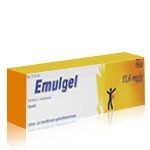Joint Inflammation and How to Treat It


Inflammation of the joint is a common medical issue that affects millions of people worldwide. It can lead to discomfort, limited mobility, and a reduced quality of life. Whether it stems from injury, autoimmune disease, or wear and tear, joint inflammation can have significant consequences if not properly addressed. In this article, we will explore what joint inflammation is, what causes joint pain, the general term used for this condition, how inflammation can be reduced, and how Emulgel — a topical anti-inflammatory formulation—can help relieve the symptoms.
What Is Inflammation of the Joint?
Joint inflammation, medically known as arthritis, is a condition in which one or more joints become swollen, painful, and stiff. The joint is where two or more bones meet, and it is surrounded by soft tissues that include cartilage, synovial fluid, ligaments, tendons, and the synovial membrane. Inflammation is the body’s natural immune response to injury or infection, intended to protect and heal. However, in the case of chronic joint inflammation, the process may become maladaptive and instead cause damage and ongoing discomfort.
Inflamed joints may exhibit symptoms such as redness, swelling, warmth, tenderness, and a decreased range of motion. The inflammation can be acute—appearing suddenly and lasting for a short period — or chronic, persisting over time and potentially leading to joint damage.
While inflammation is often associated with aging, it can occur at any age and may be the result of a wide variety of underlying conditions. Understanding the root cause is crucial in selecting the right treatment strategy.
What Causes Joint Pain?
Joint pain is a hallmark symptom of joint inflammation. It can range from mild irritation to debilitating discomfort and may be constant or intermittent. The pain typically arises from inflammation of the tissues in and around the joint, damage to the cartilage or bones, or dysfunction of surrounding muscles and ligaments.
One of the most common causes of joint inflammation and pain is osteoarthritis, a degenerative joint disease that occurs when the protective cartilage that cushions the ends of bones wears down over time. This leads to bones rubbing against each other, causing pain, stiffness, and swelling.
Another major cause is rheumatoid arthritis, an autoimmune condition in which the body’s immune system mistakenly attacks the synovial membrane lining the joints. This leads to inflammation, which can ultimately damage cartilage and bone if left untreated.
Other potential causes of joint pain and inflammation include gout, a condition caused by the buildup of uric acid crystals in the joint; bursitis, the inflammation of fluid-filled sacs (bursae) that cushion the joints; and infectious arthritis, which results from bacterial or viral infections.
Injuries, overuse, obesity, and genetic predisposition can also contribute to joint inflammation. Certain viral illnesses or underlying chronic conditions such as lupus or psoriasis may present joint pain as a symptom as well. Additionally, poor posture and repetitive strain, especially in occupational settings, can place undue stress on the joints and lead to inflammation over time.
What Is the General Term for Joint Inflammation?
The general medical term for inflammation of the joint is arthritis. This term encompasses over a hundred different types of joint disorders, each with its own cause, clinical presentation, and treatment approach. Despite the differences among the types, all forms of arthritis share one common feature: joint inflammation.
Arthritis can be broadly classified into inflammatory and non-inflammatory types. Inflammatory arthritis includes autoimmune and infectious forms such as rheumatoid arthritis and septic arthritis, while non-inflammatory arthritis typically refers to osteoarthritis, which is primarily mechanical and degenerative in nature.
It is important to distinguish between different types of arthritis to ensure proper diagnosis and management. While all arthritis involves joint inflammation, the underlying mechanisms and appropriate treatments may vary greatly.
How Do You Reduce Joint Inflammation?
Reducing joint inflammation involves addressing the underlying cause, managing symptoms, and preserving joint function. The treatment may include a combination of pharmacological therapies, lifestyle changes, physical rehabilitation, and, in some cases, surgical intervention.
Nonsteroidal anti-inflammatory drugs (NSAIDs) are commonly used to relieve pain and reduce inflammation. These medications can be taken orally or applied topically, depending on the location and severity of the symptoms. Corticosteroids, either taken orally or injected directly into the affected joint, may also be used to suppress inflammation, particularly in autoimmune or inflammatory arthritis.
Physical therapy plays an essential role in maintaining joint flexibility, strengthening muscles around the joints, and improving mobility. Low-impact exercises such as swimming, cycling, and stretching can help reduce stiffness and improve function without overloading the joints.
Weight management is another critical component of reducing joint inflammation. Excess body weight places additional stress on weight-bearing joints like the knees and hips, accelerating cartilage wear and promoting inflammation.
Diet can also influence joint health. Anti-inflammatory foods such as fruits, vegetables, fatty fish, whole grains, and nuts may help reduce systemic inflammation, while excessive consumption of sugar, refined carbohydrates, and saturated fats can contribute to inflammatory responses in the body.
In autoimmune types of arthritis, disease-modifying antirheumatic drugs (DMARDs) and biologics may be prescribed to slow disease progression and prevent joint destruction. These medications work by targeting specific components of the immune system responsible for the inflammatory response.
For localized pain and inflammation, topical treatments provide a safer alternative to systemic medications and are especially useful for people who are unable to tolerate oral NSAIDs. One such option is Emulgel, which combines anti-inflammatory action with targeted relief.
The Role of Emulgel in the Treatment of Joint Inflammation
Emulgel is a topical formulation that merges the characteristics of an emulsion and a gel, designed to deliver active anti-inflammatory ingredients directly to the affected area. One of the most commonly used Emulgel products contains diclofenac, a well-known NSAID that is effective in reducing pain and inflammation.
When applied to the skin over an inflamed joint, Emulgel penetrates the epidermis and reaches the underlying tissues, where it exerts its anti-inflammatory effects. This method of delivery is advantageous because it avoids the systemic absorption and gastrointestinal side effects commonly associated with oral NSAIDs. As a result, Emulgel is especially suitable for older adults or individuals with digestive sensitivities.
Emulgel is typically used for the relief of pain and inflammation associated with conditions like osteoarthritis, tendinitis, bursitis, and mild musculoskeletal injuries. It is also commonly recommended for athletes or individuals recovering from joint overuse or minor trauma.
In addition to its pharmacological effects, Emulgel provides a cooling sensation upon application, which may offer immediate soothing relief. Its fast-absorbing and non-greasy nature makes it convenient for regular use without interrupting daily activities.
While Emulgel can be highly effective for treating localized joint inflammation, it is most beneficial when used as part of a broader treatment strategy that includes physical activity, proper nutrition, and medical supervision. Its role is supportive — helping manage symptoms while other interventions work to address the root causes of the condition.
It is important to follow dosage and application instructions carefully when using Emulgel. Overuse or application on broken skin can increase the risk of side effects. Though rare, some individuals may experience skin irritation or allergic reactions, in which case the product should be discontinued, and a healthcare provider consulted.
Emulgel is available over the counter in many countries, but its use should be discussed with a physician, especially for chronic conditions or when combined with other medications.
Conclusion
Inflammation of the joint, or arthritis, is a prevalent health condition that can arise from various causes including injury, autoimmune disorders, and degenerative changes. Characterized by pain, stiffness, and swelling, joint inflammation can limit movement and negatively affect quality of life.
Understanding what causes joint pain and identifying the type of arthritis involved are essential steps in effective treatment. Interventions range from oral and topical anti-inflammatory medications to physical therapy, lifestyle changes, and in some cases, disease-modifying drugs.
Emulgel offers a valuable treatment option for those experiencing localized joint inflammation. Its ability to deliver targeted relief with minimal systemic side effects makes it a preferred choice for many patients, particularly those managing chronic musculoskeletal conditions. While it may not replace systemic treatments in severe cases, it plays a key role in symptom management and improving daily comfort.
By adopting a comprehensive approach that addresses both the symptoms and the underlying causes, individuals affected by joint inflammation can regain mobility, reduce discomfort, and enhance their overall quality of life.
Medically Reviewed by Dr. Faride Ramos, MD
(Updated at Jul 26 / 2025)
